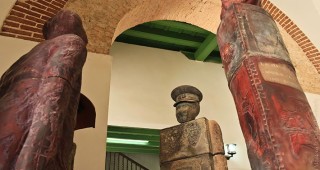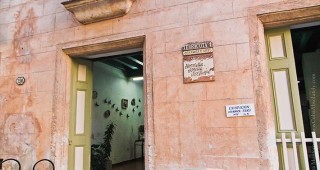A visitor to Havana soon discovers that the city is fun-loving and lively. However, not everyone is aware of the fact that a few kilometers from the city center there are “dead spots” where one can relax from car, bus and truck horns that seem to go off for any reason; the endless chatter; and the music that seems to follow passersby from street to street and house to house.
One of these refuges of silence is the Jardín Botánico Nacional (JBN), or National Botanical Garden, (Carretera El Rocío, km 3 ½, Calabazar), very close to Parque Lenin and just across the road from EXPOCUBA, the country’s largest exhibition center.
The garden began to be built in 1968, and although it was officially inaugurated in January 1989, it opened to the public on March 24, 1984 thanks to the direct participation of workers, students and professors of the University of Havana, and students of technical institutes, who worked intensively for many months. Following a master plan rigorously established on scientific bases, they planted trees and grass, and developed the phytogeographic zones and special collections in the approximately 600 hectares that are home to about 4,000 identified species, and almost 150,000 specimens.
Inherited from the former Botanical Garden of Havana, which used to be located in the grounds of the Quinta de los Molinos, the Garden’s Herbarium is a collection of nearly 200,000 specimens of plants and fungi from Cuba, and some collections from Mexico, French Guyana, Ecuador, Spain, Germany, Puerto Rico, Dominican Republic, Brazil, Venezuela, Virgin Islands and Florida, USA. The Herbarium, as well as the Scientific Collection of living plants, are extremely valuable to a specialized audience and are available to scientists, students and researchers.
Plants are organized into two main collections: the indoor collections with over 600 species, 250 genders and 90 families, and the field collections in which plants are divided into two main areas, the Cuban phytogeographic zone and the international phytogeographic zone.
The indoor collections are housed in three pavilions that are each nine meters tall. The first pavilion, known as the Crystal House, contains plants from tropical and subtropical arid regions, including the very popular cactuses. The second greenhouse exhibits plants from tropical rainforests in an environment of high humidity and 50% light. And the third pavilion is dedicated to the lush vegetation from the mountain tropical rainforests, as well as a number of plants of economic interest, such as cocoa, coffee, black pepper and vanilla, in an environment of high humidity and 25% light. Outside the greenhouses, there is a beautiful collection of ornamental aquatic and terrestrial plants.
The Cuban phytogeographic zone contains a representation of the vegetation that can be found on the island with approximately 3,500 species of plants native to Cuba, while the international phytogeographic zone contains tropical trees from Asia, Africa, the Americas and the Caribbean, Australia and Oceania. One of the most important attractions in the JBN is the Palmetum, a collection of palm trees covering an area of 50 hectares where 158 species in 55 genera of palm grow. Another significant collection is the Archaic Forest with plants that have survived to this day from the era of dinosaurs, such as coniferous trees, or prior to that, such as magnolias.
Located in the phytogeographic area of Southeast Asia is the Japanese Garden that covers an area of five hectares. The garden, which was a gift from the Japanese Government to the Cuban people, received a 20-million-yen contribution from the Japan World Exposition Commemorative Association, and was the work of the famous Japanese landscape architect Yoshikuni Araki (1921–1997). Conceived as a “kaiyū-shiki-teien,” or promenade or stroll garden, it has the typical elements of Japanese landscape gardens—beaches of stones (which were brought from Pinar del Río and Sancti Spíritus provinces and Santa Maria and Santa Cruz del Norte beaches); water in the form of a cascade and a lake, the latter with multicolored carps; gravel walks; a simplified replica of a traditional Buddhist pagoda; and a stone lantern, which is meant to symbolize the illumination of one’s path through life.
In keeping with the technique of “shakkei,” or borrowed scenery, the garden takes advantage of views outside the garden, in this case the nearby hills known as Tetas de Managua as visual axis to the contemplation of the garden. In addition, by means of the “mie-gakure” technique, the visitor can see the whole landscape from any point in the garden.
As well as plants from Southeast Asia, specimens of Pino Macho were used in lieu of Japanese pines that do not grow in tropical climates, and Cassia nodosa, whose pale pink flowers suggest cherry blossoms. Bamboo and a combination of evergreens and deciduous trees were used, allowing a sort of carpet of ferns and mosses to develop. The Japanese Garden is an invitation to tranquility and inspiration while enjoying its natural beauties.
Although there are several Cuban Creole and international menu restaurants in the Botanical Garden, many people prefer to eat at El Bambú, the popular eco-restaurant next to the Japanese Garden. The all-you-can-eat lunch buffet serves soups and salads, root vegetables, beans, rice, mushrooms, leafy vegetables, eggplant caviar, plus hibiscus and other flowers and plants that one would never consider edible, pastas, delicious toppings, sauces and condiments, most of which are grown in surrounding areas within the Botanical Garden, all cooked on a wood-fuelled fire or solar cookers. Of course, there’s no shortage of fresh fruit and juices, teas, desserts and delicate flavored ice cream sweetened with honey, with no milk or cream.
Very near the exit of the Botanical Garden, a small shop sells ornamental plants grown in the Garden’s nurseries and laboratories. The best way to enjoy the Garden is through the guided train tour that takes around two hours and explores the entire grounds of the Jardín Botánico Nacional with a 30-minute stop at the Japanese Garden.
This is a place that nature lovers will thoroughly enjoy, thanks to the park’s abundance of endemic plant species and foreign flora from all around the globe, and beautifully preserved Cuban species.


 Art Deco
Art Deco








